The Red Sea, EgyptContents of this Issue: Rendezvous Dive Adventures, British Columbia Dive Stores in the Internet Age Did This Divemaster Commit Suicide, or Was She Silenced? Raja Ampat Liveaboard Goes Down in Flames Still Unclear How Key Largo’s Get Wet Got Wet A Computer for Non-Techie Divers How Divers Can Give Back: Part I Loving the Chambered Nautilus to Death Editorial Office: Ben Davison Publisher and Editor Undercurrent 3020 Bridgeway, Suite 102 Sausalito, CA 94965 three great dive trips, three prices from the February, 2012 issue of Undercurrent
Dear Fellow Diver, An extended stay in Egypt gave me the chance to experience Red Sea diving three ways: on a budget, splurging on luxury and hard-core liveaboard. Each had its shining parts, each its quirks. My introduction to high-value, low-budget diving was through Hussein Ramadan, a local PADI instructor in the Ma'adi section of Cairo whom everyone calls "Doc." He's an old-school instructor -- serious, skill-based and always organizing trips for students and friends that won't break the bank -- and you can join him. I hooked up with Doc and a fascinating group of U.S. expats from Cairo in a caravan of vans filled with gear and goodies for a four-hour haul to Hurghada to board the Reef Master. The boat, about 120 feet long, can take up to 36 divers, though we only had a dozen. The ambitious itinerary began with dives on the popular reefs near Hurghada, including one night dive with hunting lionfish and a massive fuchsia stonefish, then touched at the Brothers Islands south of Hurghada, the reefs near Marsa Alam, and a quick return to Hurghada. Five days, 13 dives, all food, BYOB for only $840.
The fascinating people who dive with Doc made the trip. All were expats who had lived around the world and knew how to roll with the punches. Many had survived every hellhole on the planet. United by a passion for diving and a willingness to pool resources and travel cheaply, they made a sometimes-uncomfortable trip into a journey with friends. If you can rough it, the price is right and you'll have a ball. A month later, my buddy and I went to Sharm el Sheikh, where we stayed at the Four Seasons Hotel, a lavish Moorish fantasy built along a steep hill leading to the beach. Sinai Blues, its dive operation, befits a five-star hotel. Just as you hear, "My pleasure" if you ask for extra pillows, Sinai Blues echoed the hotel's fine service. Full bar available, with the spirits imported but all beers and wines made in Egypt. Most of the divers were with family, and few dove more than once a day. The capable staff, led by an elegant German named Andrea, easily set up two or three dives a day for us. They required that a dive instructor come along on every dive, which I thought unnecessary, but the multinational staff was so charming that I enjoyed their local knowledge and help. Moreover, staff washes your gear, including wetsuits, after every dive. I paid well for the privileges at Sinai Blues, but it felt great not to carry, wash or worry about a thing. They really know service.
The straits of Tiran Island features sheer walls covered with sea fans, and gorgeous reef tops with stony and soft corals and teeming with fish of every hue, particularly on the dives at Jackson and Thomas Reefs. Most of the European and Russian divers always wanted to go deep, but the real beauty was in the shallows. Dives were conducted in groups of six or fewer, so bottom time was limited by the gas consumption of the worst diver. You could have nitrox for a small extra fee; I used it on the morning dives, and air on the afternoon dives. I always returned with half a tank, which I found frustrating. Most folks were not hardcore but, as the British say, "holidaymakers." And those deep divers can suck up the air. I booked two special trips: one to the Thistlegorm wreck on the 600-HP RIB, and another on a private Zodiac for a short morning trip to putter around the tops of the reefs. Both were wonderful. Built in 1941 and bombed in 1942, the Thistlegorm's life was short. During World War II, she carried supplies for the British, and to avoid the Germans in the Mediterranean, she traveled from Britain around the Cape of Good Hope to the Red Sea. While she waited to pass through the Suez Canal, a Luftwaffe patrol bombed the sitting duck. Its twisted hull now rests at about 75 feet down. Divemaster Stuart, a native of Sheffield, knows the wreck intimately. On two dives, I came away impressed with the bombing's destruction and a powerful sense of history. The first dive covered the exterior, with its small guns and decks peeled up like sardine cans. The second covered its interior, which was filled with Wellington boots, motorcycles lined up like rentals, batteries and trucks, many still with the manufacturer's name and date. My other special dive on the reef tops, by contrast, dazzled the eye with colors and life. Vivid stony and soft corals abounded as bird wrasse, anemonefish, orange and purple anthias, and butterflyfish of every hue darted in and out. This dive experience allowed me to do exactly what I wanted -- wallow to my heart's content in the incredible reef without being leashed by the rapid air consumption of a group, or stuck going deep with a group.
The hotel dive package comes with transfers and a superb daily buffet breakfast. Rooms, many with sea views, are comfortable, and the on-site spa offers great treatments and exercise classes. Room service was 24/7, and though it falls a little short, it's much better than most Egyptian hotels. (My room far excelled that of friends staying at the Hyatt). The resort is family-friendly, with a kids club and many activities for tweens and teens. Families told me they loved bringing their kids there because it allowed them to have their diving fun while kids were safely engaged, and the staff clearly doted on the children. Don't bother buying anything Egyptian at the gift shop -- alabaster tea light holders that cost $2.65 in Cairo go for $30 here. Taxi tariffs were about 10 times higher than in Cairo. In November, I spent a week on Blue O Two's Blue Fin with 23 divers, mainly from the U.K., and a few Norwegians and Americans. Cabins -- king suites and twins -- had ample storage and mini-fridges and warm hooded robes to wear on deck before and after dives. The king suites came with plasma televisions with HDMI and USB2 hookups to use for video cameras, external hard or thumb drives, or one of the boat's external drives packed with movies. Avoid Cabins 1 and 2 in the stern; they are prone to loud engine noise, problematic during late-night crossings. I always bring good earplugs and try to think of engine or anchor noise as soothing. This time, it didn't always work. The "Best of the Brothers," itinerary focused on the two islands an eight-hour steam south of Hurghada. Each has sheer walls, stony and soft coral covers and massive sea fans drinking in the currents. Checkout dives were off Hurghada, where many day boats literally raft together. Though divers swamped the sites, I enjoyed them. The patch reefs and small pinnacles offer lots to see for those who care to look: crocodilefish, other lurk-and-lunge predators from scorpionfish to lionfish, and plenty of rabbitfish, wrasses, unicornfish, and various parrotfish and surgeonfish. The Brothers came with a series of 5:30 a.m. wakeup calls. You can't do night dives there by law, so we started early. The first dive was always worth it, because I saw at least two thresher sharks (and several on an afternoon dive). Half of its body is composed of a curving graceful tail, the thresher swims with sinuous grace. It swats small fishes with that huge tail, then gobbles up the stunned creatures. Gray reef sharks also showed up on several dives, one which was known to the guides as "the big girl." I saw Napoleon wrasse on every dive, and some seemed to use divers as stalking horses. I also saw a few barracuda and, on my last dive there, a large tuna. Count on no more than three dives per day at the Brothers. A steam south brought us to Panorama Reef and the Seven Pinnacles near Safaga, the port for Luxor and its famous archaeological sites, Karnak and the Valley of the Kings. Panorama Reef lived up to its name, combining wall and plateau around 80 feet, and shallows sparkling with color, stony corals and fish. I noticed tridacna clams abounding there, but they tend to be integrated into coral heads and rarely exceed one foot wide. There were many Clark's anemonefish, some so pugnacious that it was a relief they are so small. I confess to forgetting to mention fish so common that I started not to notice them -- flocks of coronetfish everywhere, and many blue-spotted stingrays lurking on every sandy bottom. Safaga was the only area besides Sharm where I saw turtles, all of them hawksbills. Head dive guide Achmed and his colleague, Abdu, coordinated diving based on conditions, which could be very rough indeed. In fact, one of the two inflatables was pushed onto a shallow reef at the southern end of Little Brother, and was literally deflated and unusable. It meant one fewer dive at the Brothers and an extra dive at Safaga. No problem for me as I tire of wall dives, even with sharks, because the topography becomes dull, but one diver complained about being cheated of a last wreck dive on Big Brother. Gotta roll with what happens if you are going to enjoy a liveaboard. The boat finished the trip with dives 16 and 17 near its Hurghada port. Because Egypt is a desert, many think it's always hot. Excepting the summer and early September, the water is chilly. I wore a 7-mm steamer and 7-mm hooded vest on most dives and was not cold. In September, the water around Hurghada was about 80 degrees; at Sharm el-Sheikh in October, it was 78; and in November at the Brothers, it ranged from 71 to 76, with one night dive a chilly 66 degrees. One British diver wore a drysuit so he was the only one not to suffer. The water can be rough and the wind can cut through you. Be prepared for the fleet of liveaboards at the Brothers -- there were 16 between Little and Big Brother, and this is in post-revolutionary Egypt, when tourism is way down. The captains talk with each other, and folks more or less stay out of each other's way, but on some dives, I saw more people than big fish. Also, come prepared with a safety sausage on a reel. It's required, and though the boat will loan you one, it's wise to carry one with which you are familiar. Blue Fin asks you do safety stops with the sausage aloft for the Zodiac to find you easily when you ascend. The cabins are wired for 220 volts with two-pin European plugs; hair dryers are not provided, nor is shampoo, though there is liquid soap. The boat uses a membrane system to fill EAN tanks, safer than carrying lots of oxygen but slower than a titrated fill (at least two-and-a-half hours to fill all divers' tanks). The exceptional deck crew helped with hanging suits, putting on fins and bringing juice after each dive. Achmed's dive briefings were detailed, well illustrated and thoughtful, as were the choices of sites. You could choose a guide or go with your buddy. Food was ample, surprisingly healthy with lots of fruits and veggies, and dietary needs were accommodated with grace. The food was less spicy than I prefer, but geared to western palates. Special mention goes to steward Hamdi, who not only cleaned up each cabin between dives, but also sometimes let his imagination run wild. I returned to arrangements of my duvet and towels that had me in stitches -- a swan-shaped duvet wearing my baseball cap and glasses was my favorite! Blue O Two runs a first-rate operation, from their offices in the U.K. to their Red Sea vessels. If you value service, professionalism, good food, and intelligently thought-out diving, they offer good value. Regardless of how you dive the Red Sea, with a good operator, you're destined for excellent diving. -- J.D.
|

I want to get all the stories! Tell me how I can become an Undercurrent Online Member and get online access to all the articles of Undercurrent as well as thousands of first hand reports on dive operations world-wide
| Home | Online Members Area | My Account |
Login
|
Join
|
| Travel Index |
Dive Resort & Liveaboard Reviews
|
Featured Reports
|
Recent
Issues
|
Back Issues
|
|
Dive Gear
Index
|
Health/Safety Index
|
Environment & Misc.
Index
|
Seasonal Planner
|
Blogs
|
Free Articles
|
Book Picks
|
News
|
|
Special Offers
|
RSS
|
FAQ
|
About Us
|
Contact Us
|
Links
|
3020 Bridgeway, Ste 102, Sausalito, Ca 94965
All rights reserved.

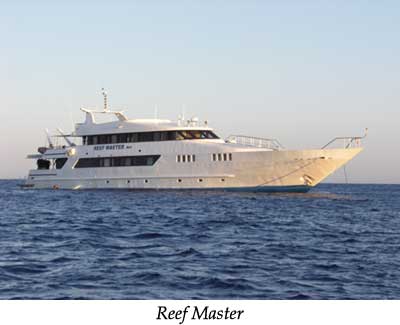 Diving (air only) was from one small Zodiac. We boarded
fully geared up, no matter the seas. With limited staff, extra
help for every diver was not possible. Frankly, I hated boarding
a bouncing inflatable in four-foot seas. Standing on the
dive deck, then stepping
onto the inflatable
edge and then its
floor was an accident
waiting to happen for
most of us. Entries
from the Zodiac were
backrolls, and like
every inflatable I've
dived in the Red Sea,
one re-enters dolphinstyle
after doffing
all gear but fins. Or
walrus-style for those of us lacking cetacean grace, with crew
dragging as one kicked one's way over
the edge. Each dive was accompanied by
a divemaster, either Doc or one trained
by him. One divemaster turbo-charged his
way through the water, and I learned to
remain at my lazy pace and not let him
dictate what was for me too darn fast.
Doc also dives rather quickly for my
taste, and I noticed that several experienced
divers also kept their own slothful
paces, but both Doc and his divemasters
were fine with that.
Diving (air only) was from one small Zodiac. We boarded
fully geared up, no matter the seas. With limited staff, extra
help for every diver was not possible. Frankly, I hated boarding
a bouncing inflatable in four-foot seas. Standing on the
dive deck, then stepping
onto the inflatable
edge and then its
floor was an accident
waiting to happen for
most of us. Entries
from the Zodiac were
backrolls, and like
every inflatable I've
dived in the Red Sea,
one re-enters dolphinstyle
after doffing
all gear but fins. Or
walrus-style for those of us lacking cetacean grace, with crew
dragging as one kicked one's way over
the edge. Each dive was accompanied by
a divemaster, either Doc or one trained
by him. One divemaster turbo-charged his
way through the water, and I learned to
remain at my lazy pace and not let him
dictate what was for me too darn fast.
Doc also dives rather quickly for my
taste, and I noticed that several experienced
divers also kept their own slothful
paces, but both Doc and his divemasters
were fine with that.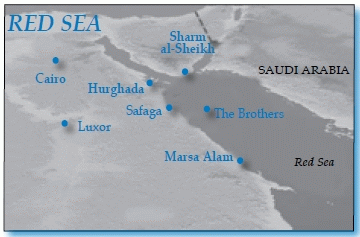 Reef Master cabins included doubles,
triples, and quads, mostly bunks. They
were fine, a little cramped and short
on storage, with small ensuite bathrooms. Food was Egyptian: kefta, koshery, tahini,
hummus, and salads. Breakfast featured the Egyptian national dish, fuul, (fava beans
cooked long and spiced with vinegar, cumin, and pepper). No one went hungry. Some divers
brought a variety of home-cooked treats, and cheerfully shared yummies like brownies.
The boat itself is one reason the price is right. Though comfortable enough, its
furnishings were plastic and rather garish, and at times functioned like the African
Queen. During the hottest part of September, the air-conditioning went out on the third
day, and sleeping on deck meant virtually no cushioning and lots of motion. When things
broke, like my cabin toilet, they were only partially or temporarily repaired; broken
lights just stayed broken. Like all electrical outlets in Egypt, they were two-prong
European style and 220v.(Bring a EuroSurge unit for your laptops and sensitive electronics
to protect against current fluctuations).
Reef Master cabins included doubles,
triples, and quads, mostly bunks. They
were fine, a little cramped and short
on storage, with small ensuite bathrooms. Food was Egyptian: kefta, koshery, tahini,
hummus, and salads. Breakfast featured the Egyptian national dish, fuul, (fava beans
cooked long and spiced with vinegar, cumin, and pepper). No one went hungry. Some divers
brought a variety of home-cooked treats, and cheerfully shared yummies like brownies.
The boat itself is one reason the price is right. Though comfortable enough, its
furnishings were plastic and rather garish, and at times functioned like the African
Queen. During the hottest part of September, the air-conditioning went out on the third
day, and sleeping on deck meant virtually no cushioning and lots of motion. When things
broke, like my cabin toilet, they were only partially or temporarily repaired; broken
lights just stayed broken. Like all electrical outlets in Egypt, they were two-prong
European style and 220v.(Bring a EuroSurge unit for your laptops and sensitive electronics
to protect against current fluctuations).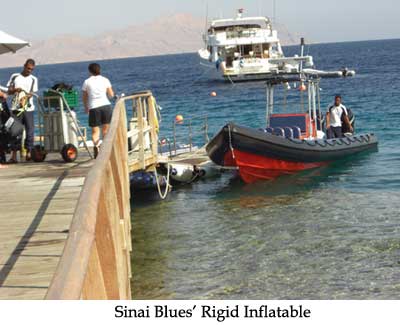 Sinai Blues runs not just the usual
Zodiacs but also a bad-ass machine -- a rigid
inflatable (RIB) with two Mercury 300-hp, fourstroke
outboards designed for search and rescue.
This beast flew at up to 55 knots, taking
us to sites like the Thistlegorm wreck in an
hour, rather than the four or five hours other
operators needed. The most distant sites in the
Straits of Tiran were only 10 minutes away.
The ride is not for the faint of heart. At 30
knots, any wave hits hard, and when she was
cooking at more than 40 knots, you had to post,
as if riding a galloping horse, to keep your spine intact. Thrilling, terrifying, but
worth it to get places fast.
Sinai Blues runs not just the usual
Zodiacs but also a bad-ass machine -- a rigid
inflatable (RIB) with two Mercury 300-hp, fourstroke
outboards designed for search and rescue.
This beast flew at up to 55 knots, taking
us to sites like the Thistlegorm wreck in an
hour, rather than the four or five hours other
operators needed. The most distant sites in the
Straits of Tiran were only 10 minutes away.
The ride is not for the faint of heart. At 30
knots, any wave hits hard, and when she was
cooking at more than 40 knots, you had to post,
as if riding a galloping horse, to keep your spine intact. Thrilling, terrifying, but
worth it to get places fast.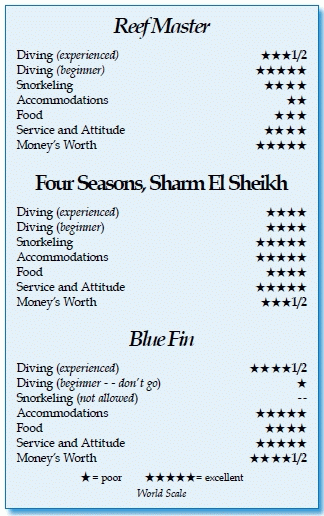 You can also book trips to Ras Mohammed's reefs if enough divers sign up. Both the
Thistlegorm and the Ras Mohammed trips cost a hefty tariff above the regular rate, as
do extra dives (each dive package comes with two dives per day per room, meaning one
dive per day per person if you go with your buddy). My buddy and I did 12 dives each
in 5.5 days, and paid extra but considered it money well spent. The Thistlegorm trip
on the RIB cost $300 per person, the extra night dives $85 each. Andrea gave me a good
price of $80 on the private reef-top. Some divers pooh-poohed the house reef as dull
but at night, I found shrimp, baby cuttlefish, octopi, crinoids, basket stars, hunting
Volatans lionfish, and even flashlight fish abounding in the nooks and crannies.
Turning off my light, I was surrounded by eerie, bluish, flashing lights of the little
fish communicating with each other. Magical.
You can also book trips to Ras Mohammed's reefs if enough divers sign up. Both the
Thistlegorm and the Ras Mohammed trips cost a hefty tariff above the regular rate, as
do extra dives (each dive package comes with two dives per day per room, meaning one
dive per day per person if you go with your buddy). My buddy and I did 12 dives each
in 5.5 days, and paid extra but considered it money well spent. The Thistlegorm trip
on the RIB cost $300 per person, the extra night dives $85 each. Andrea gave me a good
price of $80 on the private reef-top. Some divers pooh-poohed the house reef as dull
but at night, I found shrimp, baby cuttlefish, octopi, crinoids, basket stars, hunting
Volatans lionfish, and even flashlight fish abounding in the nooks and crannies.
Turning off my light, I was surrounded by eerie, bluish, flashing lights of the little
fish communicating with each other. Magical.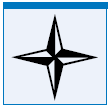 Divers Compass: Dr. Hussein Ramadan's dive trips on the Reef Master
usually occur every two to three weeks; five days cost about $840,
and no beer or wine on the boat, but you can BYOB . . . One week on
the Blue Fin, with four dives a day, cost $1,650; Egyptian-made beer
is $4, wine bottles from $16 to 35, and free soft drinks . . . Direct
flights to Cairo from the U.S. include Egyptair (which serves no alcohol),
Turkish Airlines via Istanbul, American Airlines and British
Airways via Heathrow, Lufthansa via Frankfurt, Air France via Paris, and United Airlines; prices vary wildly between seasons, with highs of $2,400 on
American/British Airways around the Christmas holidays to $660 on Turkish Airlines during
low season . . . Egyptair offers a "business" class ticket that allows 30 kilos
of checked luggage (rather than 20 in coach) and a snack, though seats are identical
to coach . . . Direct flights to Hurghada and Sharm el-Sheikh abound from Europe;
check U.K. and European travel sites for deals, and Blue O Two can find charters and
cheap flights for you as well . . . You may not carry alcohol with you on flights
within Egypt that aren't direct transfers . . . Contact info: Reef Master - contact
Dr. Ramadan at
Divers Compass: Dr. Hussein Ramadan's dive trips on the Reef Master
usually occur every two to three weeks; five days cost about $840,
and no beer or wine on the boat, but you can BYOB . . . One week on
the Blue Fin, with four dives a day, cost $1,650; Egyptian-made beer
is $4, wine bottles from $16 to 35, and free soft drinks . . . Direct
flights to Cairo from the U.S. include Egyptair (which serves no alcohol),
Turkish Airlines via Istanbul, American Airlines and British
Airways via Heathrow, Lufthansa via Frankfurt, Air France via Paris, and United Airlines; prices vary wildly between seasons, with highs of $2,400 on
American/British Airways around the Christmas holidays to $660 on Turkish Airlines during
low season . . . Egyptair offers a "business" class ticket that allows 30 kilos
of checked luggage (rather than 20 in coach) and a snack, though seats are identical
to coach . . . Direct flights to Hurghada and Sharm el-Sheikh abound from Europe;
check U.K. and European travel sites for deals, and Blue O Two can find charters and
cheap flights for you as well . . . You may not carry alcohol with you on flights
within Egypt that aren't direct transfers . . . Contact info: Reef Master - contact
Dr. Ramadan at 